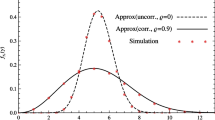Abstract
In this paper we investigate the impacts of spatial fading correlation on channel capacity of orthogonal space–time block codes (STBCs) over multiple-input multiple-output Nakagami-\(m\) fading under different power and rate allocation policy. This paper presents the single-input single-output equivalency of STBC which is equivalent to scalar additive white Gaussian noise channel, with a channel gain proportional to the Frobenius norm of the matrix channel. We derive the characteristic function (c.f.) of the signal-to-noise ratio at the output of the STBC decoder, when spatial fading correlation is assumed. The c.f. turns out to be a linear combination of Laplace transforms weighted by the eigenvalues of the channel correlation matrix, where each element corresponds to an elementary Gamma probability density function. Based on this approach, and using the linearity of the Laplace transform, the capacity expressions are derived for STBC under different adaptive transmission policy. Numerical results illustrate the impact of fading correlation and fading severity on the channel capacity and outline the performance differences between the distinctive adaptation policies.




Similar content being viewed by others
References
Zheng, L., & Tse, D. N. C. (2003). Diversity and multiplexing: A fundamental tradeoff in multiple antenna channel. IEEE Transactions on Information Theory, 49(5), 1073–1096.
Alamouti, S. M. (1998). A simple transmit diversity technique for wireless communication. IEEE Journal Selected Areas in Communications, 16(8), 1451–1458.
Tarokh, V. H., Jafarkhani, H., & Calderbank, A. R. (1999). Space–time block codes from orthogonal designs. IEEE Transactions on Information Theory, 45(5), 1456–1467.
Sandhu, S., & Paulraj, A. (2000). Space time block codes: A capacitive perspective. IEEE Communication Letters, 4(12), 384–386.
Marzetta, T. L., & Hochwald, B. M. (1999). Capacity of a mobile multiple-antenna communication link in Rayleigh flat fading. IEEE Transactions on Information Theory, 45, 139–157.
Telatar, I. E. (1995). Capacity of multi-antenna Gaussian channels. AT&T Bell Labs., Internal technical memorandum.
Foschini, G. J., & Gans, M. J. (1998). On limits of wireless communication in a fading environment when using multiple antennas. Wireless Personal Communications, 6, 311–355.
Goldsmith, A. J., & Varaiya, P. P. (1997). Capacity of fading channel with channel side information. IEEE Transaction on Information Theory, 43(6), 1986–1992.
Alouini, M. S., & Goldsmith, A. J. (1999). Capacity of Rayleigh fading channels under different adaptive transmission and diversity combining technique. IEEE Transactions on Vehicular Technology, 48(4), 1165–1181.
Mallik, R. K., Win, M. Z., Shao, J. W., Alouini, M. S., & Goldsmith, A. J. (2004). Capacity with adaptive transmission with maximum ratio combining in correlated Rayleigh fading. IEEE Transactions on Wireless Communications, 3(4), 1124–1133.
Maaref, A., & Aïssa, S. (2005). Capacity of space time block codes in MIMO Rayleigh fading with adaptive transmission and estimation errors. IEEE Transactions on Wireless Communications, 4(5), 2568–2578.
Gozali, R., & Woerner, B. D. (2002). On the robustness of space–time block codes to spatial correlation. In Proceedings of IEEE vehicular technology conference (VTC-S’02) (pp. 832–836), Birmingham, Al.
Jorswieck, A. E., & Sezgin, A. (2004). Impact of spatial correlation on the performance of orthogonal space–time block codes. IEEE Communications Letters, 8(1), 21–23.
Femenias, G. (2004). BER performance of linear STBC from orthogonal designs over MIMO correlated Nakagami-\(m\) fading channels. IEEE Transactions on Vehicular Technology, 53(2), 307–317.
Mallik, R. K. (2003). The pseudo-Wishart distribution and its application to MIMO systems. IEEE Transactions on Information Theory, 49(10), 2761–2769.
Turin, G. L. (1960). The characteristic function of Hermitian quadratic forms in complex normal variables. Biometrika, 47(1/2), 199–201.
Musavian, L., Dohler, M., Nakhai, M. R., & Aghvami, A. H. (2004). Closed form capacity expressions of orthogonolized correlated MIMO channels. IEEE Communications Letters, 8(6), 365–367.
Bellman, R. E., & Roth, R. S. (1984). The laplace transform. Singapore: World Scientific.
Gradshteyn, I. S., & Ryzhik, I. M. (2000). Table of integrals, series and products (6th ed.). San Diego, CA: Academic Press.
Lombardo, P., Fedele, G., & Rao, M. M. (1999). MRC performance for binary signals in Nakagami fading with general branch correlation. IEEE Transactions on Communications, 47(1), 44–52.
Author information
Authors and Affiliations
Corresponding author
Rights and permissions
About this article
Cite this article
Chauhan, S.S., Kumar, S. Capacity Analysis of Adaptive Transmission with Space–Time Block Codes in Spatially Correlated MIMO Nakagami-\(m\) Fading Channels. Wireless Pers Commun 79, 1211–1222 (2014). https://doi.org/10.1007/s11277-014-1925-6
Published:
Issue Date:
DOI: https://doi.org/10.1007/s11277-014-1925-6




